The Google Nexus 6P Review
by Andrei Frumusanu on December 16, 2015 8:00 AM ESTBattery Life
Battery life on the Nexus 6P will be a quite interesting story. On one hand we have a very large 3450mAh battery, but on the other hand we have an AMOLED screen that is less efficient than most LCDs, all of which is driven by the Snapdragon 810, which trails in efficiency. Due to the Note 5 and Mi Note Pro both sharing the same form-factor and a 5.7” 1440p screen, they present perfect comparison devices that isolate either the screen advantage or disadvantage (Mi Note Pro) or the SoC differences between the devices (Note 5).
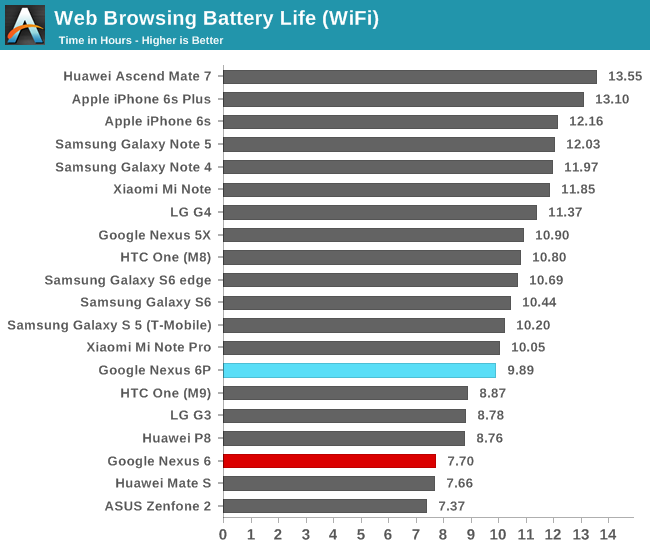
We start with our web-browsing battery test. Here we see the Nexus 6P reach 9.9h of runtime. While by itself this doesn’t represent a very bad figure and most people would be able to make do with such a number, when comparing it to other devices it represents a quite disappointing performance as the increased battery size doesn’t seem to give the 6P any advantage. The 6P reaches same battery figure as the Mi Note Pro which sports a smaller 3090mAh battery (11% disadvantage). As both devices sport the same SoC, any difference in the web browsing test is most likely due the power efficiency disadvantage of the AMOLED screen on the part of the 6P.
On the other hand if we want to look at the difference in efficiency of SoC, we can use the Note 4 as a relatively fair comparison. The Nexus 6P sports a screen that is ~5% more efficient and has a 7% advantage in battery capacity, yet it manages to fall behind the Note 4 with Snapdragon 805 by 16%, or almost 2 full hours.
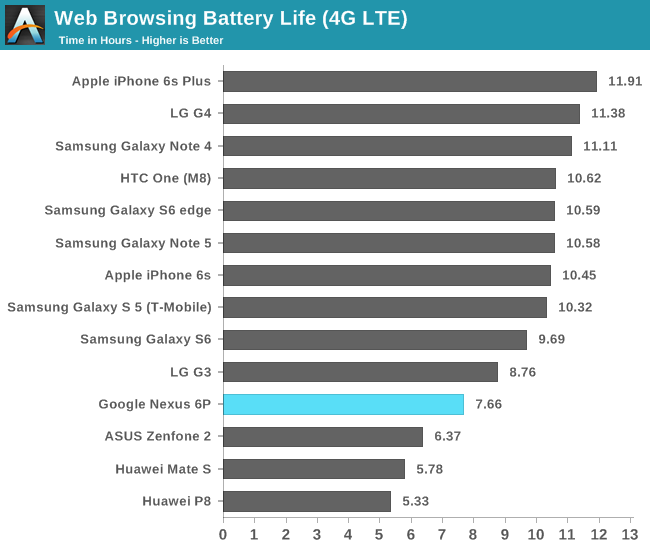
On the 4G LTE test, as with other reviews in the past I have to warn that I have worse cell network signal conditions compared to our other mobile reviewers Joshua Ho and Brandon Chester, making this not a fully accurate apples-to-apples comparison in terms of testing conditions. Keeping that in mind, we see the Nexus 6P also struggle to compete with the other devices in our results database.

PCMark’s battery life test is a more balanced workload that compromises of more real-world use-cases. Due to the test also having a lower average picture level (darker contents), the AMOLED screen is able to regain competitiveness against the Mi Note Pro. Again, mostly due to the efficiency disadvantage of the SoC, the differences between the Nexus 6P and the Note 5 remain large in this test as the former manages to last almost 1.5h longer even though the 6P has a 15% larger battery. Disregarding the competition, the 6P still manages to show some good battery scores in this test, although we do have some concerns over the performance demonstrated in the writing-subtest.

BaseMark OS II’s battery test is a very heavy CPU test that if more of a sustained performance and overall device TDP benchmark. Here the Nexus 6P lasts a little over 4 hours. As we’ve seen in the device thermals section from earlier, there’s a significant difference in long-term performance between devices even if they sport the same SoC.
How long a device can last in such a heavy load test is thus mostly a function of the thermal settings of the device, which does not give any good indication of the overall efficiency of the device. For example a given device can end up with a low battery runtime, but may have actually have better efficiency than one with higher battery runtimes. This rule is generally limited to synthetic scenarios as real-world scenarios where a device is thermally limited are generally rare.
Again for this review I feel I need to go a tangent to better explain why the Nexus 6P ends up with the battery life it has. The Snapdragon 810 and 808 unfortunately suffer from exceptionally bad efficiency that affects most of this year’s devices, Nexus 6P included. As we can see in the above graph, both SoCs exhibit worse performance/W efficiency than last year’s Snapdragon 800 series (805 included). For the Nexus 6P this is especially worrying as it would mean the device is actually less efficient than the Nexus 6 when it comes to computational loads. Unfortunately it seems that this year Samsung is alone in being able to showcase an improvement over last year’s devices courtesy of the Exynos 7420 enjoying a 2-3x lead in power efficiency over this year's competing high-end SoCs.
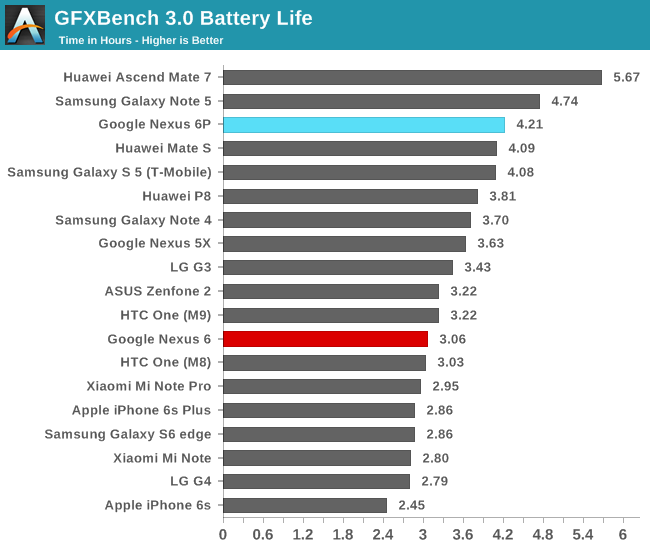
Lastly on GFXBench, the Nexus 6P ends up with 4.2 hours runtime on the on-screen battery test. This is a good result for the phone, even though it’s required to throttle to about 50% of its peak performance for most of the duration of the test to maintain reasonable skin temperatures. Here Qualcomm still has a considerable advantage over ARM’s Mali GPUs so that the Adreno 430 still is very competitive even though it has to deal with a process node disadvantage. It will be definitely be interesting to see how the Snapdragon 820’s Adreno 530 will be able to shake up the field.
Overall, the Nexus 6P offers what one would subjectively call good battery life. The large battery largely makes up for any SoC inefficiencies and we’ve even seen that the AMOLED display is near being on par with LCD’s power efficiency. If I seem a bit harsh it’s because I cannot shake the feeling that had the Nexus 6P come out with either the Snapdragon 805 or 820 we’d have seen much better battery figures more in line with the Note 5.
Charge Time
The Nexus 6P ships with a 3A@5V charger. The charger uses a USB Type-C connector, so you need a Type-C to Type-C cable to be able to charge the device. The Nexus 6P does ship with one out of the box, but I question Google’s decision as it would have been much more practical to receive a more traditional USB A to USB C cable to allow the Nexus 6P to charge from existing sources without having to buy an additional cable (technically the 6P does also come with such a cable, but at only about 15cm in length it’s very impractical).
The Nexus 6P along with the 5X are some of the first devices to come with USB Power Delivery 2.0, the official specification for device charging as opposed to more proprietary charger communication protocols such as those from Qualcomm (Quickcharge) or Adaptive Fast Charging that is used in Samsung chargers.
What seems to be interesting about the charging behaviour is that there’s visibly more charging “steps” than other devices. The period that is usually called the fast-charging phase of the charging cycle runs up to 40% battery capacity. Here the battery cell receives up a bit over 12.5W of charge power, after which it steadily reduces the input current until it enters another charge pattern from 50 to 80% coming in at around 10W. Finally at 80% the device switches to trickle-charging as the input current exponentially decays over time.
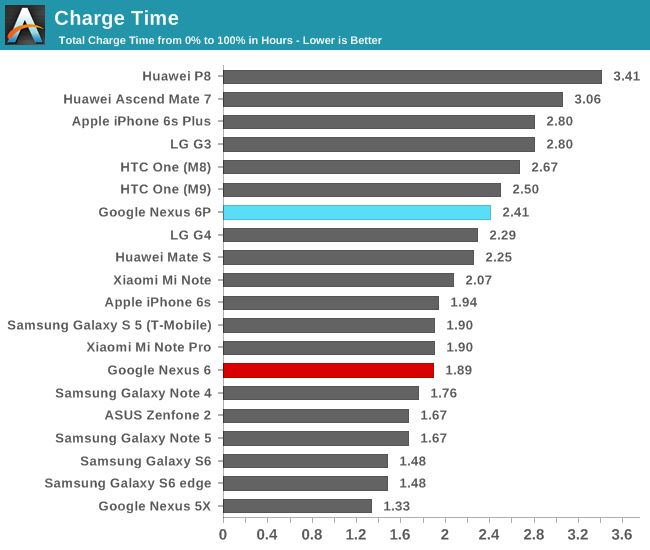
What is worrying is that the battery charge indicator is extremely inaccurate at high charge levels. The device reports 100% much earlier than other devices. In fact there’s still over 2W of power coming into the battery as it reports being fully charged. This goes on for another 40 minutes, representing an actually significant amount of energy representing about 7% of the battery’s true capacity. As such, the Nexus 6P doesn’t receive a good grade in the charge time metric due to its misleading charging indicator behaviour.
Nevertheless, it’s able to charge from 0 to 40% in 30 minutes which is outstandingly fast. 45 to 80% takes about an equal amount of time which means for the large majority of use-cases where you are in desperate need of power the Nexus 6P will be able to serve you well (As long as you have your charger and cable with you).


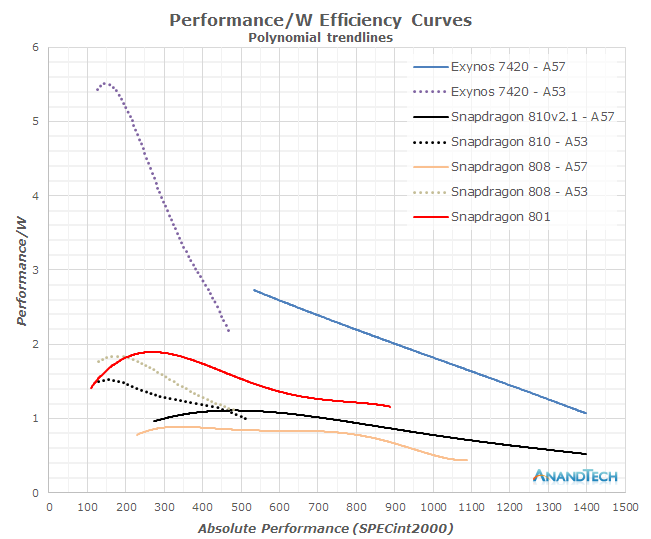
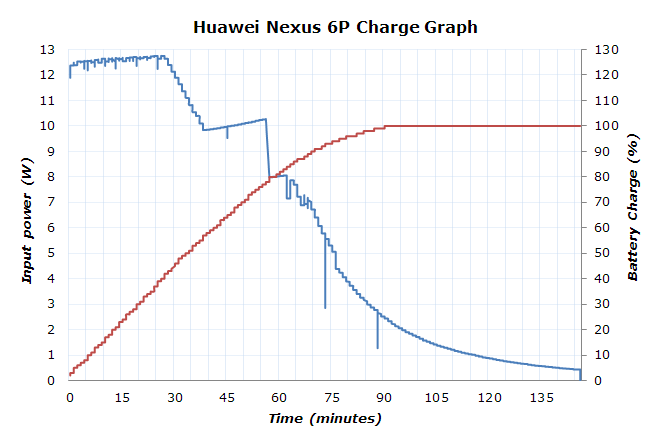








219 Comments
View All Comments
Ethos Evoss - Sunday, December 20, 2015 - link
are u so stupid and believe this site lies that crappy iphone has better battery ??? ar you so stupid or u just joking ?? I HOPE u joking..tipoo - Wednesday, December 16, 2015 - link
Not a horrible showing for the 810, but as Googles selected partner-in-flagship one may have hoped they did a little more.The more interesting phones in the 810 space will be the 950 XL and the Xperia Xperia Z5, which both came to the solution of slapping heat pipes onto the 810, I think simultanously both for the first time in phones. I'm surprised it took so long really. Curious about the throttling of those, or at least the Z5 if WP makes the former harder to compare.
twizzlebizzle22 - Wednesday, December 16, 2015 - link
I'm sure I remember reading previous sony phones, Z2/Z3/Z4 has heatpipe designs.Impulses - Wednesday, December 16, 2015 - link
It's definitely not the first time heat pipes show up in a phone, I remember being surprised over seeing them in one at least a year ago... May have been Sony's own line, but it's not a new thing conceived exclusively because of 810..tipoo - Wednesday, December 16, 2015 - link
Ah, ok, right you both are. First to try one on the 810 then?Tech_guy - Wednesday, December 16, 2015 - link
Embarrassing throttling yet again. Qualcomm has really hurt Android flagships this year. Also using 1440p is stupid when the 810 was already known for heating issues.syxbit - Wednesday, December 16, 2015 - link
Yep. Qualcomm is single handedly responsibly for the terrible performance of almost all flagship Android devices shipped in 2015.What a terrible year. If only another SoC vendor could have capitalized on this. Nexus has used Qualcomm in all their phones for the 4th year running now. This would have been the year to dump Qualcomm for someone else!
(note, I have a 6P. Despite the diversity of Android, there isn't much choice if you want high end stock)
Impulses - Wednesday, December 16, 2015 - link
Then if you want a flagship phone that isn't a phablet your choices grow even slimmer... N5X is still bigger than my N5, so that leaves the Z5c, meh... Might just do the unthinkable and hang unto the N5 for more than 2 years.anandreader106 - Wednesday, December 16, 2015 - link
@Impulses There are many of us that have made the same exact conclusion. I'll continue using my N5 for the next 1-2 years as well.Anustart - Wednesday, December 16, 2015 - link
Bought the 6p after having my iPhone for 2 months. Returned the 6p. Lack of 1080p 60fps , ois and not as smooth as everyone is saying are the main reasons. Maybe I'll try android again when note 6 comes out. Right now iPhone is best phone right now and that's coming from someone who had at least 25 phones in the past 2 years. Only thing I miss from android atm is customization and xposed for YouTube ad block.